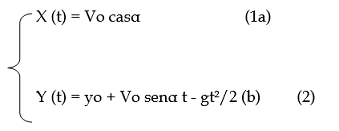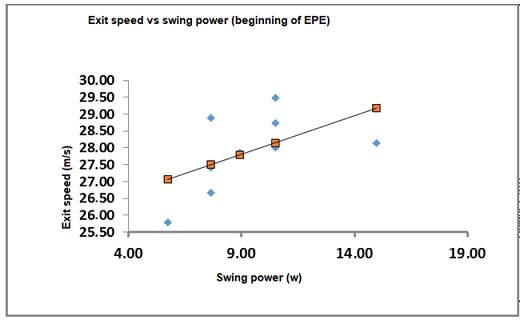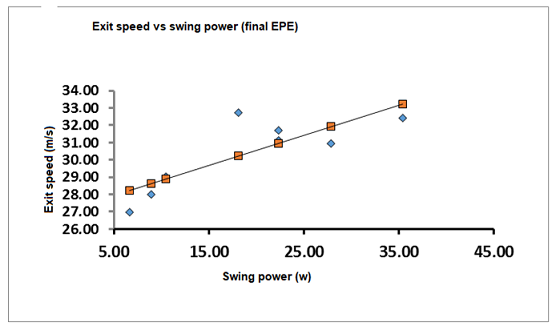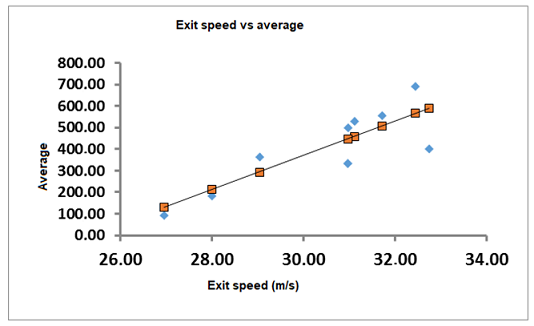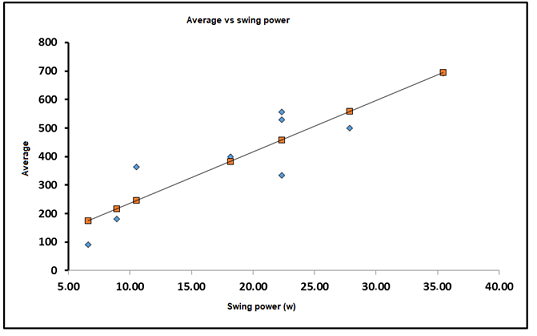Mi SciELO
Servicios Personalizados
Articulo
Indicadores
-
 Citado por SciELO
Citado por SciELO
Links relacionados
-
 Similares en
SciELO
Similares en
SciELO
Compartir
Ciencia y Deporte
versión On-line ISSN 2223-1773
Ciencia y Deporte vol.8 no.3 Camagüey sept.-dic. 2023 Epub 11-Sep-2023
http://dx.doi.org/10.34982/2223.1773.2023.v8.no3.011
Original article
Post-Impact Bat Speed in Holguin Baseball Team
1Universidad de Holguín. Facultad de Informática Matemática. Holguín, Cuba.
2Universidad de Holguín. Facultad de Cultura Física. Holguín, Cuba.
3Centro Provincial de Medicina del Deporte. Holguín, Cuba.
Introduction:
Post-impact ball speed is one of the most important metrics in baseball; however, in Cuba, the women's baseball has not conducted studies in this area. In the training of the first-category women baseball players in Holguin, for the Eastern Tournament, 2021, this issue was examined.
Aim:
To determine the relation between swing power and post-impact speed and between them and the batting average recorded in training matches.
Materials and methods:
Speed measurements and swing time were performed using a batting tee and a Sony speed gun.
Results:
Two simple physical-mathematical models were used to estimate the trajectory of the ball hit and swing power, and a set of weight exercises was designed to increase explosive strength.
Conclusions:
The regression and correlation methods permitted the estimation of the adjustment of a functional-linear ratio, the existence of a positive correlation between swing power and exit speed, and a much stronger linear correlation of the same sign between the batting average and the exit speed and batting average, and swing power, following the implementation of the exercise set.
Key words: Baseball; post-impact ball speed; swing power; correlation; and regression.
INTRODUCTION
The progress of science and technology calls for a closer relationship with several other disciplines, such as biomechanics, physics, and mathematics. Optimizing techniques through scientifically-planned training was one of the most relevant elements to train high-performance female baseball players. Along with the coaches' expertise, several contributions from the previously mentioned sciences could be articulated to the most advanced conceptions of sports training.
Baseball comprises four basic abilities in the game: catching, throwing, running, and batting. The game's dynamic requires certain conditions, both on the offensive and the defense. The existence of differences in the different positions of the players on the field should be taken into account, as well as the fundaments of throwing and batting in baseball are technical critical moves in the game's dynamic. Hence, determining the factors that influence them is a significant endeavor, which in many cases, comes along with the conscious application of physical-mathematical principles.
Batting is one of the actions that contribute the most to results in baseball; its techniques constitute the most difficult element to master. Consequently, the systematic evaluation of batting is an important part of baseball athlete training. Reynaldo, (1998 and Reynaldo 2018). Overall, batting demands the coordination of muscle efforts to provide greater speed when swinging, which means higher ball speed when hit.
Various relevant results have been reported as to the development of such practices, which convert the athlete's general strength into special strength transmitted to the bat (De León, 2006). It may favor the occurrence of powerful connections, with higher exit speeds (VS) once the batting technique is accomplished well. Accordingly, the outcomes will largely depend on the motor potential of the athlete (Verkhoshansky, 2002).
This is a direct result of the fact that both the batting mechanics and strength mechanics can be improved. Hence, the search for ways to achieve continuous increments of strength capacity is essential to monitor its progress by setting the correct metrics during sports training.
Although exit speed analysis (Statcast, 2020) is one of the indirect procedures to evaluate batting strength, it has not been studied in Cuban women's baseball. Bailey et al. (2018) noted recent progress in professional baseball statistics, indicating a systematic use of this variable. Moreover, research done on its link to swing power and speed has been lacking in the Cuban academic context of quantitative treatments, considering the existing physical-mathematical models, as part of rigorous studies done by various researchers, such as Adair (2002).
The post-impact ball speed (VS) is the speed acquired by the ball right after the bat makes contact with it. Its magnitude represents one of the most frequently studied batting metrics; it constitutes an indirect measure of the mechanical energy that a player can transfer to the ball using a bat. In baseball jargon, the term post-impact ball speed is the metric for hitting power or batting power.
Although it might not be one hundred percent accurate, physically speaking, since it expresses speed measured as strength, it makes sense, because batting involves actions with dynamic magnitudes, such as power and torque in mechanical work, and therefore, energy ratios, which somehow justify the terminology.
One of the models assumed in the analysis related to the particle: a body with some baseball-like mass whose dimensions (diameter or radius) can be disregarded in a first approximation. This body is projected upon hitting, creating a horizontally-directed angle moving lowly. The mathematical expressions used result from the integration of the system of ordinary differential equations to describe the movement referred to (Bahill, 2018).
In the case of single-plane movements, the following initial conditions are set Equation 1:
The solutions to this system are based on parametric equations of the trajectory, given by these expressions Equation 2:
Where: g- the value of gravity acceleration; á -angle created between the horizontal direction and the ball exit.
The post-impact ball speed also depends on the point where the bat hits the ball, the ball's mass and hardness, and the bat's speed, among others (Slinkar, 2020). The last one constitutes another critical magnitude to which the highest attention should be paid, since it is linked to the swing and its strength, and therefore, the batter's strength and ability to exert adequate torque and speed on the bat, along with angular acceleration, which will eventually translate into post-impact ball speed.
The expressions for the calculations of linear and angular accelerations, as well as batting power are deducted according to a more complicated modeling. The primary rationales assumed are the following: both the bat and the athlete are bodies, so their dimensions are not insignificant.
Under such circumstances, the model adopted for the swing is a pure rotation of the body-bat system around an imaginary vertical axis along the batter. Koenig, Hanningan and Clutter (2004) .
Although simple, this model permitted the consideration of important elements that participate in the swing, and to perform preliminary estimations. The body-bat system acceleration exists between the resulting torque created by the batter (T) and the opposite one caused by the aerodynamic drag force (TAED). The application of the law of conservation of the angular moment enables the following Equation 3:
Where:
ω = dø/dt |
angular speed; α : angle described during the system's movement |
Kd |
is the aerodynamic parameter that depends on air density, the drag force coefficient, and the diameter and length of the arm-bat system, the main elements subject to the aerodynamic drag force |
I = IB + Ibat |
the moment of total inertia of the system produced by the sum of the moment of bat inertia (Ibate ) and the moment of batter inertia (Ig ) |
The application of the work-energy theorem for rotation enabled Equation 4.
Taking the system's initial angular speed into account ω0= 0 and that the power is the quotient of work done and time during which torque functions, the following expression can be obtained Equation 5:
According to 5, power depends on the total inertial moment of the body-bat system (I) of swing duration (Δt), and the square of the final angular speed.
Considering the relevance of batting and the issue with metric identification in Cuban female baseball that permits an evaluation of the behavior of this skill during training, the purpose of this paper is to determine the swing power and post-impact ball speed ratio, and between them and the players batting average.
MATERIALS AND METHODS
The explosive strength exercise protocol was used to test the female baseball players of the Holguin team, looking to their participation in the national championship. A non-probabilistic sampling was performed, in which the population and the samples coincided.
RESULTS AND DISCUSSION
Two batting sessions were observed: one at the beginning and the other at the end of the special stage (EE or EPE). In each moment, the post-impact ball speed was measured, along with the swing time. The players were briefly instructed on the type of batting action in the final stage, consisting of concentrating their strength at the beginning of the swing, the moment, impact, and post-impact. They were also told to observe every requirement for effective practice.
According to the skills observed upon finishing the first practice, a set of strength exercises was designed to tackle the upper body to increase the players' explosive strength. EPE consisted of three mesocycles: basic developer, intensive impact, and basic stabilizer. The first and third ones comprised four micro cycles, whereas the second had five micro cycles.
Speed measurements (post-impact) as well as the swing execution times were made in field No. 2 at the Mayor General Calixto Garcia Stadium, using a Sony speed gun radar (vertical axis). The data were processed on a Toshiba R950 portable computer. A standardized protocol in which each player used the same bat to hit the ball three times, the ball was placed on a batting tee and was directed to a net. All the variables were measured at every batting time.
The average speed values and swing execution times were calculated, along with the angular speed and arm power. The values of the last two magnitudes recorded from the cinematic ratio involving the reason for the change in the angle described and time, using formula 4, respectively. The data were collected directly from Koenig, Hanningan, and Clutter (2004).
Kd = 0.0078 N.m.s² ; ø = 135 ͦ ≈ 2.36 rad; Ib = 0.311 kg.m². The batting inertia moment neared the aIbat = 0.468 kg.m² a, according to the National School Athletic Association (2006).
The trajectory graphs took different inclination angles and exit speeds and were constructed according to the general Cartesian equation of the trajectory deducted from the parametric equations 1a and 1b, excluding the time.
The swing power and post-impact ball speed were analyzed in combination with their two aspects: correlation to determine their ratio degree and regression to explore the character of the functional ratio. The average and post-impact ball speeds were analyzed similarly, considering the performance recorded at different training matches during the special stage (EE). Only the nine players who reported official batting times were included.
Based on the model used for low ball movement, the analytical expressions that describe their trajectories were checked; it also included their graph representations in two cases: different exit angles with the same speed value and for different speeds and the same exit angle.
In the former, the well-known outcome is associated with the distance reached by the ball with an increment of the inclination angle for values below the critical angle value. In the latter, the outcome evidenced that the distance reached by the ball increases if the initial or exit speeds are higher, depending on the inclination angle.
A relevant result was the design of a set of weight exercises directed to muscle groups (MG): MG arms, MG legs, and MG trunk-back. The sets consisted of basic and auxiliary exercises for different MG and combined auxiliary exercises. The latter group enabled explosive strength in arms and legs and led to stronger MG, including the back muscles.
The exercises for the training of explosive strength and its variants were performed using the corresponding methodological exercises. These could help develop muscle groups and provide greater explosive strength. Consequently, the capacity to transmit movement to the body-bat system can be possible in the shortest time possible during the batting action.
Another set of actions was associated with the implementation of the solid rigid model to the body-bat system, considering the aerodynamic drag force and the work-energy theorem. An expression was deducted to estimate the batting power. It was calculated for every single player, before and after the set of exercises was put into practice, resulting in higher values.
Likewise, the post-impact ball speed was higher upon the application of the new strength exercises. An acceptable correlation level between the player's batting average and the exit speeds at the end of the special training was observed in the special stage (EPE).
Figure 1 represents the trajectories made by the ball after the impact, with different angles, determined according to the model solutions 1a and 1b.
The initial post-impact ball speed was thought to be constant, with the corresponding maximum value of the averages calculated for the values from every player. Along with the value expressed in meters per second (m/s), the equivalent in miles per hour (mph) was given (Figure 1).
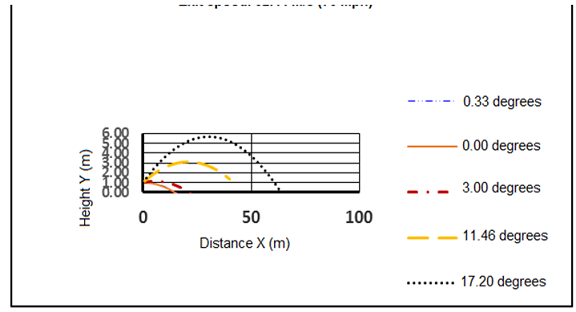 Source: Made by the authors (2020)
Source: Made by the authors (2020)Fig. 1. - Effects of the batting angle on the distance and height reached by the ball
The exit angle was defined as the angle made by the horizontal direction and the direction of the ball speed after impact. The batting angle made by the direction of the bat speed and the horizontal coincides with the exit speed. The value of the initial speed coincides with the post-impact ball speed (in this case assumed as constant), whereas the angle values did not go over 17.20º.
As could be seen, a greater exit angle increases the distance made in the horizontal axis (reach), provided that the angular values are lower than the value for which this distance is the maximum. The maximum height of the ball was greater too. These facts are well-known and coincide qualitatively with the reports in the literature (Adair, 2015): 117, figure 7.3.
Depending on this result, strength training is recommended to achieve post-impact ball speed with a greater batting angle, near the optimum, and permits long-distance connections. In men's baseball, the studies suggest a speed of 40 m/s (90 mph). According to biomechanical research, a ball that has just been impacted by the bat at that speed (144 km/h) can travel to around 300 feet (90 m). For every additional mph (1.6km/h) the distance grows between 4 and 6 feet (1.2-1.8m), depending on the exit angle and the initial speed (Astraword Press, 2020; Pocket Radar, 2020). Therefore, it is important to pursue higher values in the training sessions.
According to the review conducted in this study, no references have been observed in terms of the post-impact ball speed value that must be reached in Cuban female baseball practices. The maximum average values of this kind in the female Holguin baseball team are within 26.96; 32.44 m/s expressed in percentage, being the interval [65;81 %] of the value recommended for men. However, the authors consider that to obtain higher values, a harder effort must be done, considering the physical aspect associated with the low-ball movement in the earth's gravity pull is the same. The basic differences between these aspects lie in the strength training capacities and some tactical and technical elements.
The height and distance variations resulting from the post-impact ball speed are shown in Figure 2. Among the speed values (VS) were selected from four of them as a way of illustrating the distance and height differences. The batting angle was constant and reached 17.20 degrees, whereas each curve corresponds to a speed value (VS).
An increase was observed in the distance with speed increases. Because the exit speed measurements were conducted according to norms, including a protective net, the trajectory of the ball hit by a bat with the proper exit angle, is interfered by that net. On the contrary (absence), the trajectory adopted the profile presented according to the model assumed (Figure 2)
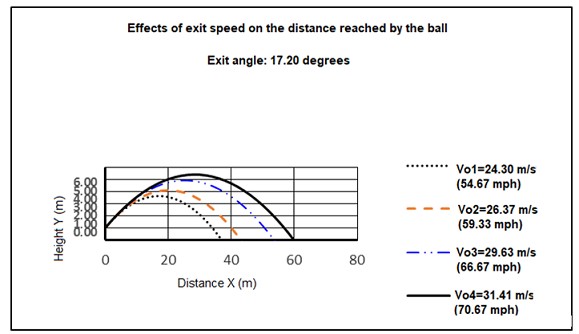 Source: Made by the authors (2020)
Source: Made by the authors (2020)Fig. 2. - Effects of exit speed on the distance reached by the ball
The trajectory graphs were similar to the ones reported by Adair (2015). The differences observed were only attributed to the values of the initial speed and angles. Thus, Figure 3 coincides with the one represented in Figure 2 1, and Figure 7.19. Figure 2. coincides with the results in Figure 2. 4. 21 and figure 7.19. Baghill (2018: 192). R. Adair considered that in the rotation of the ball, the speed range variations are between 80 and 120 mph, and the inclination angle was 35o, whereas, in this paper, the working range was 25.19; 32.44 m/s, or 25.19; 32.44, mph, with an angle of 17.20o
The spin effects (rotation) were ruled out in either case, though their influence was insignificant on the general character of the parabolic movement, as described by Adair (2015): 21.23, figures 2.4 and 2.6, when the balls are animated, going from a spin to angular moment. Nevertheless, in softball, which is similar to baseball, in which the balls have greater diameter and mass, the spin does not influence the character of the movement, it does influence distance. According to Cross's results (2011) 46, figure 3.4, the ball travels longer if it has little rotation under the assumption that its initial speed and angle are constant.
Figures 3 and 4 represent the curves achieved upon the regression analysis of variables post-impact ball speed and swing power, at the beginning and the end of EPE (Figure 3 and Figure 4).
The analysis of residues against the levels of the regression levels pointed to an acceptable adjustment of the model to fit the data. Likewise, the analysis of variation sources indicated that the sum of the squares explained by the regression in figure 4, was lower than the one corresponding the sum of 5. Hence, the determination coefficient of this last case (67 %) was lower than the former (29 %), which indicated the existence of better adjustment of the linear model in the final EPE, since the data proportion explained by the model was greater Montgomery (2004)
The values of the Pearson coefficient correlation were obtained in each case they are: Rp = o.53 beginning of EPE and Rp = o.82 in the final. These results show that if the variables have a moderate and positive correlation at the beginning of EPE; in the end, they are strong and have the same sign. It may be an indicator that the exercises suggested contribute to better training of explosive strength, which in biomechanics corresponds to the fact that if batting takes place at short intervals swing power increases. It also led to greater transference of energy when the ball is impacted, with the ensuing higher post-impact ball speed.
Linares Borroto (2011) conducted a study on male baseball players in the lower categories. He reported a significant increase in general strength and swing power resulting from a system of exercises that includes strength tests from a standing position, lying down, and squatting with weights. However, he does not refer to the calculation method for swing power, whereas the post-impact ball speed was not considered.
The regression outcomes between the post-impact ball speed and average (Ave) and the swing power and average (Figure 5 and Figure 6)
The analysis of residues did not reveal serious difficulties, so the linear regression model was suitable for data fitting. The value of the determination coefficient was high in the two cases; though Ave-Pswing was greater (80%) than Ave Vs, (71%), a symptom that it is better for the Ave-Pswing.
The correlation coefficient for the variables Ave and Vs resulted in Rp =0.83, whereas Ave and Pswing Rp= 0.90. Sheppard (2017) reported the existence of a strong correlation between the batting average and the post-impact ball speed in a qualitative plane.
CONCLUSIONS
The post-impact ball speed constituted a batting metric with a strong and positive correlation with the offensive average. Though swing power has a stronger and same-sign correlation with that variable, representing control parameters for consideration with the strengthening of muscle groups trained through explosive strength during the special stage to pursue higher offensive performance in the female baseball players.
REFERENCIAS BIBLIOGRÁFICAS
Adair, R. K. (2002). Spin and the magnus coefficient. The physics of the baseball, 3rd edn. Harper Collins Publishers Inc: New York. https://www.worldcat.org/es/title/1014066926 [ Links ]
AstraWord Press Theme. (2020). BRXPerfomance. 5 Keystoexitvelocity. https://brxperformance.com/5-keys-to-exit-velocity/ [ Links ]
Bahill, T. (2018). The Science of Baseball. Modeling Bat-Ball collisions and the Flight of the Ball. Switzerland: Springer Publishing Company. https://link.springer.com/book/10.1007/978-3-319-67032-4 [ Links ]
Bailey, C., Mcinnis, T., Nilson, K., Batcher, J. and Trey, N. (2018). Bat swing ground reaction force characteristics & ball exit velocity in collegiate baseball players. National Strength and Conditioning Association. Indianapolis. Conference: NSCA National Conference, Indianapolis, IN, USA 14/07/2018 DOI:10.13140/RG.2.2.22730.26563 https://www.researchgate.net/publication/326557729_BatSwingGroundReactionForce CharacteristicsBallExitVelocityinCollegiateBaseballPlayers [ Links ]
Cross, R. (2011). Physics of baseball & softball. Springer Science & Business Media. https://link.springer.com/book/10.1007/978-1-4419-8113-4 [ Links ]
Koenig, K., Mitchell, N. D., Hannigan, T. E., & Clutter, J. K. (2004). The influence of moment of inertia on baseball/softball bat swing speed.Sports Engineering, 7, pp. 105-117. https://link.springer.com/article/10.1007/BF02915922 [ Links ]
De León Rodríguez, R. P., & Rodríguez, J. L. (2006). El entrenamiento del bateo en el equipo Las Tunas durante las series nacionales XL, XLII y XLIII. Efdeportes. Revista Digital Buenos Aires 11(100). https://efdeportes.com/efd100/bateo.htm [ Links ]
Linares, P. (2011). Sistema de ejercicios para mejorar la aceleración y potencia del swing en los atletas de béisbol de la categoría 15-16 de la EIDE Carlos Leiva González. Efdeportes. Revista Digital Buenos Aires, 16(160), https://www.efdeportes.com/efd160/mejorar-la-potencia-del-swing-de-beisbol.htm [ Links ]
Montgomery, C. (2004). Diseño y análisis de experimentos. La Habana: Félix Varela. https://books.google.com.cu/books/about/Dise%C3%B1o_y_an%C3%A1lisis_de_experimentos.html?hl=es&id=TJFoAAAACAAJ&redir_esc=y [ Links ]
Reynaldo, F. (1998a). El bateo, sus técnicas. Chiriquí. Panamá. Editorial: Impresos Modernos, David. [ Links ]
Reynaldo, F. (2018b). Del Béisbol Casi Todo. La Habana. Editorial: Científico-Técnica, https://books.google.com.cu/books/about/Del_b%C3%A9isbol_casi_todo.html?id=rstEzQEACAAJ&redir_esc=y [ Links ]
Verkhoshansky, Y. (2001). Teoría y metodología del entrenamiento deportivo (Vol. 24). Editorial Paidotribo. https://books.google.com.cu/books/about/Teor%c3%8da_Y_Metodolog%c3%8da_Del_Entrenamiento.html?id=rcHpCFKiQUoC&source=kp_book_description&redir_esc=y [ Links ]
Received: April 04, 2023; Accepted: May 24, 2023











 texto en
texto en 


